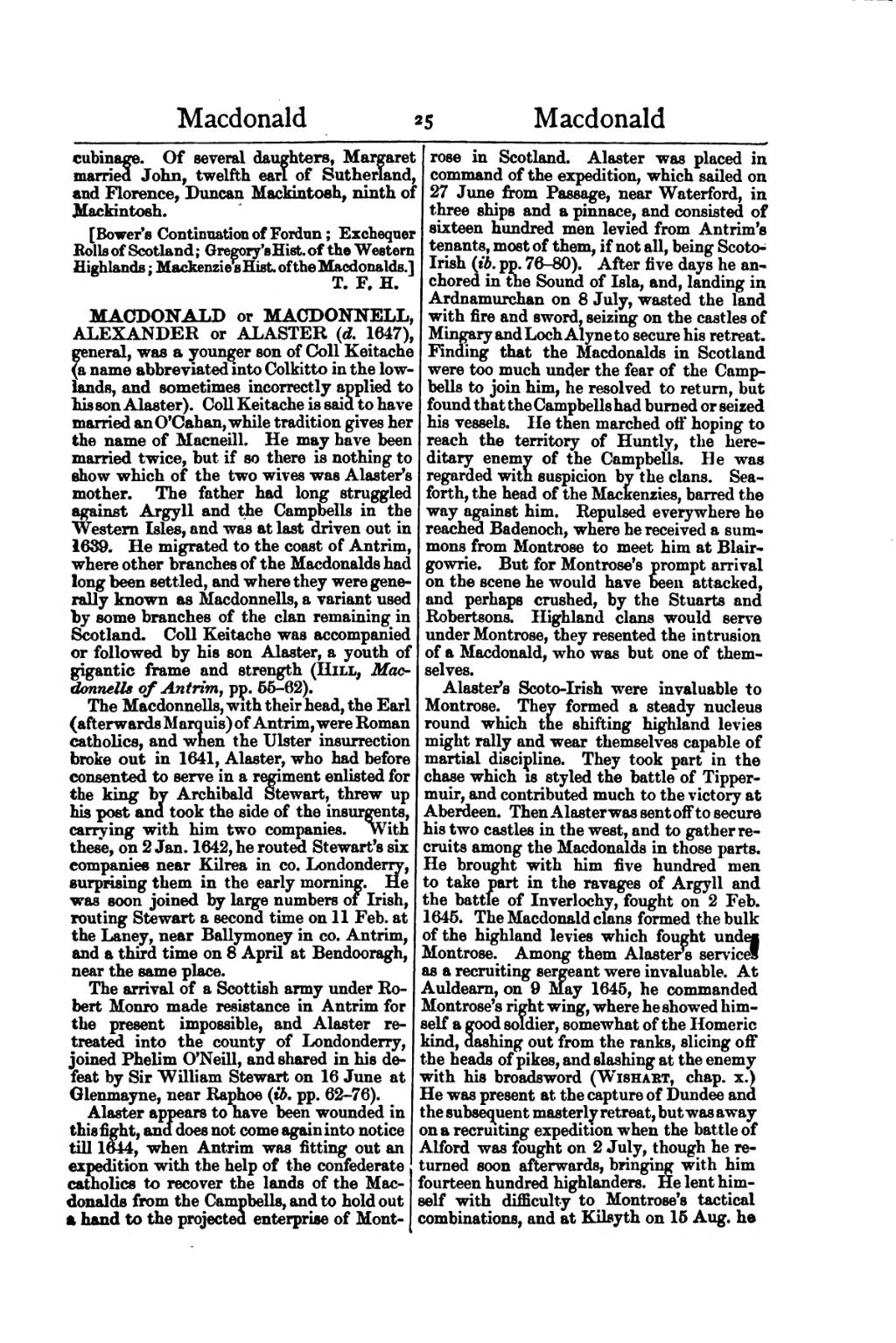cubinage. Of several daughters, Margaret married John, twelfth earl of Sutherland, and Florence, Duncan MacIntosh, ninth of MacIntoch.
[Bower's Continuation of Fordun; Exchequer Rolls of Scotland; Gregory's Hist. of the Western Highlands; Mackenzie's Hist. of the Macdonalds.]
MACDONALD or MACDONNELL, ALEXANDER or ALASTER (d. 1647), general, was a younger son of Coll Keitache (a name abbreviated into Colkitto in the lowlands, and sometimes incorrectly applied to his son Alaster). Coll Keitache is said to have married an O'Cahan, while tradition gives her the name of Macneill. He may have been married twice, but if so there is nothing to show which of the two wives was Alaster's mother. The father had long struggled against Argyll and the Campbells in the Western Isles, and was at last driven out in 1639. He migrated to the coast of Antrim, where other branches of the Macdonalds had long been settled, and where they were generally known as Macdonnells, a variant used by some branches of the clan remaining in Scotland. Coll Keitache was accompanied or followed by his son Alaster, a youth of gigantic frame and strength (Hill, Macdonnells of Antrim, pp. 55–62).
The Macdonnells, with their head, the Earl (afterwards Marquis) of Antrim, were Roman catholics, and when the Ulster insurrection broke out in 1641, Alaster, who had before consented to serve in a regiment enlisted for the king by Archibald Stewart, threw up his post and took the side of the insurgents, carrying with him two companies. With these, on 2 Jan. 1642, he routed Stewart's six companies near Kilrea in co. Londonderry, surprising them in the early morning. He was soon joined by large numbers of Irish, routing Stewart a second time on 11 Feb. at the Laney, near Ballymoney in co. Antrim, and a third time on 8 April at Bendooragh, near the same place.
The arrival of a Scottish army under Robert Monro made resistance in Antrim for the present impossible, and Alaster retreated into the county of Londonderry, joined Phelim O'Neill, and shared in his defeat by Sir William Stewart on 16 June at Glenmayne, near Raphoe (ib. pp. 62–76).
Alaster appears to have been wounded in this fight, and does not come again into notice till 1644, when Antrim was fitting out an expedition with the help of the confederate catholics to recover the lands of the Macdonalds from the Campbells, and to hold out a hand to the projected enterprise of Montrose in Scotland. Alaster was placed in command of the expedition, which sailed on 27 June from Passage, near Waterford, in three ships and a pinnace, and consisted of sixteen hundred men levied from Antrim's tenants, most of them, if not all, being Scoto-Irish (ib. pp. 76–80). After five days he anchored in the Sound of Isla, and, landing in Ardnamurchan on 8 July, wasted the land with fire and sword, seizing on the castles of Mingary and Loch Alyne to secure his retreat. Finding that the Macdonalds in Scotland were too much under the fear of the Campbells to join him, he resolved to return, but found that the Campbells had burned or seized his vessels. He then marched off hoping to reach the territory of Huntly, the hereditary enemy of the Campbells. He was regarded with suspicion by the clans. Seaforth, the head of the Mackenzies, barred the way against him. Repulsed everywhere he reached Badenoch, where he received a summons from Montrose to meet him at Blairgowrie. But for Montrose's prompt arrival on the scene he would have been attacked, and perhaps crushed, by the Stuarts and Robertsons. Highland clans would serve under Montrose, they resented the intrusion of a Macdonald, who was but one of themselves.
Alaster's Scoto-Irish were invaluable to Montrose. They formed a steady nucleus round which the shifting highland levies might rally and wear themselves capable of martial discipline. They took part in the chase which is styled the battle of Tippermuir, and contributed much to the victory at Aberdeen. Then Alaster was sent off to secure his two castles in the west, and to gather recruits among the Macdonalds in those parts. He brought with him five hundred men to take part in the ravages of Argyll and the battle of Inverlochy, fought on 2 Feb. 1645. The Macdonald clans formed the bulk of the highland levies which fought under Montrose. Among them Alaster's services as a recruiting sergeant were invaluable. At Auldearn, on 9 May 1645, he commanded Montrose's right wing, where he showed himself a good soldier, somewhat of the Homeric kind, dashing out from the ranks, slicing off the heads of pikes, and slashing at the enemy with his broadsword (Wishart, chap. x.) He was present at the capture of Dundee and the subsequent masterly retreat, but was away on a recruiting expedition when the battle of Alford was fought on 2 July, though he returned soon afterwards, bringing with him fourteen hundred highlanders. He lent himself with difficulty to Montrose's tactical combinations, and at Kilsyth on 15 Aug. he

